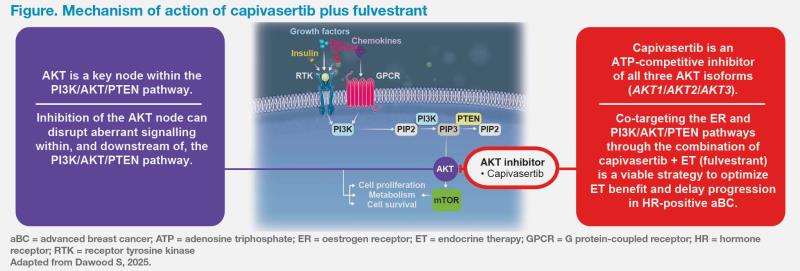Targeting the PI3K/AKT/ PTEN pathway in HR+/HER2- metastatic breast cancer





When treating hormone receptor–positive (HR+), HER2-negative (HER2-) metastatic breast cancer (mBC), it is important to target the oestrogen receptor (ER) pathway for as long as the disease remains endocrine-sensitive. In an interview with MIMS Oncology, Dr Shaheenah Dawood, Head of the Oncology Clinical Trials Programme and Director of Oncology Services at Mediclinic City Hospital, Dubai, United Arab Emirates, described how co-targeting both the PI3K/AKT/mTOR and ER pathways with capivasertib and fulvestrant optimizes endocrine therapy (ET) to benefit patients with PIK3CA/AKT1/PTEN-altered HR+/HER2- mBC. Exhausting ET before chemo in HR+/HER2- mBC.
Exhausting ET before chemo in HR+/HER2- mBC
The first-line (1L) standard of care for HR+/HER2- mBC is ET combined with a cyclin-dependent kinase 4/6 inhibitor (CDK4/6i). [EMJ Oncol 2025;13:2-9] “Subsequent treatment sequencing for HR+/ HER2- mBC is determined by endocrine sensitivity, disease burden, duration of 1L ET or time before recurrence [indicating ET sensitivity], and the tumour’s molecular profile,” noted Dawood.
After progression on 1L ET, treatment options for endocrine-sensitive disease include switching to another ET, or using targeted therapies for specific molecular alterations. [ESMO Metastatic Breast Cancer Living Guideline, v1.2 2025; EMJ Oncol 2025;13:2-9]
The European Society for Medical Oncology (ESMO) 2025 living guidelines for HR+/HER2- mBC recommend exhausting all available ET options before resorting to chemotherapy, unless organ failure is imminent. [ESMO Metastatic Breast Cancer Living Guideline, v1.2 2025; Breast 2025;82:104485]
“I [only] use chemotherapy in patients with rapid disease progression, visceral crisis, symptomatic burden requiring quick cytoreduction, or when ET-based approaches are unlikely to be effective,” shared Dawood. “To postpone the need for chemotherapy, it is important to target the ER pathway for as long as the disease remains endocrine-sensitive.”
Biomarker testing determines 2L ET choice
“Biomarker testing at progression will show which potentially targetable mutations may be driving the endocrine resistance, and will inform the choice of targeted therapy,” explained Dawood.
ET resistance in ER+/HER2- mBC can be driven by ER-dependent resistance (eg, ESR1 mutation) or ER-independent resistance (eg, PI3K/AKT pathway upregulation). [Ther Adv Med Oncol 2022;14:17588359221113694] “Molecular testing to guide treatment choice is recommended at diagnosis and at disease progression,” added Dawood.
Targeting the PI3K/AKT/ mTOR pathway
PIK3CA mutations, which are clinically actionable, are found in 30–40 percent of patients, while AKT1 and PTEN alterations are present in 5–10 percent. “Collectively, PIK3CA, AKT1 and PTEN mutations can be detected in up to 50 percent of patients at diagnosis. At disease progression, availability of that information guides subsequent treatment,” emphasized Dawood. [Cancer Treat Rev 2025;135:102924]
Activation of the PI3K/AKT/mTOR pathway shortens survival and leads to ET resistance in patients with ER+/ HER2- mBC, providing a strong rationale for targeting these signalling proteins. Co-targeting both the PI3K/AKT and ET pathways and capivasertib plus fulvestrant is a viable strategy to prolong benefit from ET. (Figure) [Cancer Treat Rev 2025;135:102924; Dawood S, 2025]

Of note, capivasertib is an ATP-competitive inhibitor of all three AKT isoforms (AKT1, AKT2, AKT3), thereby suppressing the overactivation of the PI3K/AKT pathway. (Figure) [Crit Rev Oncol Hematol 2024:200:104404]
CAPItello-291: Capivasertib plus fulvestrant
“Co-targeting both the PI3K/AKT and ER pathways with capivasertib and fulvestrant offers a validated strategy to optimize ET benefit for patients with PIK3CA/AKT1/PTEN-altered mBC,” noted Dawood. “Fulvestrant’s binding to the ER reduces oestrogen-driven tumour growth, while AKT inhibition by capivasertib provides a complementary, non–cross-resistant mechanism.”
The phase III CAPItello-291 trial investigated the efficacy of capivasertib plus fulvestrant in patients with HR+/HER2- mBC who had a relapse or disease progression during or after treatment with ET. Most patients (69.1 percent) received prior CKD4/6i for advanced breast cancer. [N Engl J Med 2023;388:2058-2070]
Capivasertib plus fulvestrant significantly prolonged median progression-free survival (mPFS) vs fulvestrant alone in the overall population (7.2 vs 3.6 months; hazard ratio, 0.60; 95 percent confidence interval [CI], 0.51–0.71; p<0.001) and in patients with PIK3CA, AKT1, or PTEN alterations (7.3 vs 3.1 months; hazard ratio, 0.50; 95 percent CI, 0.38–0.65; p<0.001). These outcomes were similar irrespective of prior CDK4/6i treatment.
“With the overall survival [OS] data at 28 percent maturity, a trend favouring capivasertib plus fulvestrant was seen in both the overall and AKT pathway–altered populations,” said Dawood.
“Although alpelisib plus fulvestrant showed a 7.9-month numeric improvement in median OS in the SOLAR 1 trial, the majority of patients [94.5 percent] in that trial had not previously received CDK4/6i, making it a less relevant model for modern treatment where prior CDK4/6i exposure is common,” she commented. “However, there are trials to show that the combination is effective even post progression on CDK4/6i.”
“Clinically, the combination of capivasertib plus fulvestrant is an effective option for patients with PIK3CA/AKT1/PTEN-altered mBC, including those with PIK3CA mutation only,” said Dawood.
Safety profile
Capivasertib plus fulvestrant has a manageable safety profile characterized by frequent but usually low-grade adverse events, including diarrhoea (72.4 percent; grade 3, 9.3 percent), rash (38.0 percent; grade 3, 12.1 percent) and nausea (34.6 percent; grade 3, 0.8 percent). [N Engl J Med 2023;388:2058-2070]
The rate of hyperglycaemia was 16.3 percent (grade 3, 2.3 percent) with capivasertib plus fulvestrant and 63.7 percent with the PI3K inhibitor alpelisib plus fulvestrant (grade 3, 32.7 percent). [N Engl J Med 2023;388:2058-2070; N Engl J Med 2019;380:1929-1940]
“Because PI3K activation occurs upstream of AKT in the insulin signalling axis, PI3K inhibition can lead to more pronounced insulin resistance and hyperglycaemia than AKT inhibition,” Dawood explained. “Inhibiting AKT directly impairs insulin signalling downstream, but some compensatory pathways may still modulate glucose metabolism, so the hyperglycaemia profile can differ between AKT and PI3K inhibitors.”
The median onset time of diarrhoea, rash, and hyperglycaemia was within 15 days. [ESMO Open 2024;9:103697] “Patient education, prophylactic management, and treatment interruption to address these AEs helped maintain patients’ quality of life [QoL] in the CAPItello-291 trial,” she added.
Global health status (GHS) and QoL were maintained for longer and EORTC QLQ-C30 scores showed less decline with capivasertib plus fulvestrant vs fulvestrant alone. Diarrhoea events were tolerable, could be managed with anti-diarrhoeal treatment, and did not negatively impact GHS/QoL. [N Engl J Med 2023;388:2058- 2070; ESMO Open 2024;9:103697]